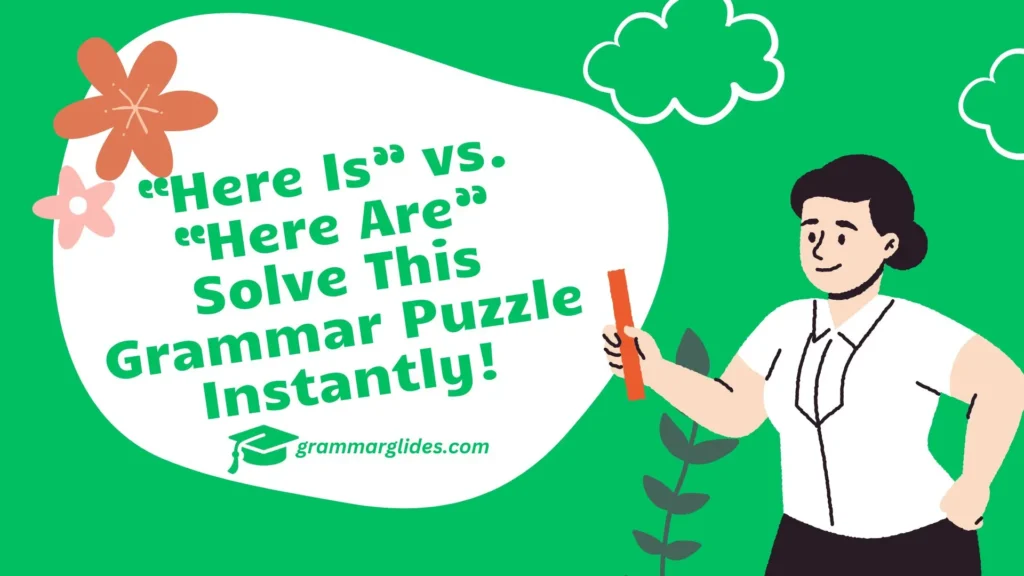Confused between “Here is” and “Here are”? Let’s clear that up with easy tips and examples.
English grammar often presents challenges, especially when it comes to understanding the correct use of similar phrases like “Here is” and “Here are.” These two expressions may seem simple at first, but knowing when to use each one can make a big difference in speaking and writing correctly. In this post, we will explain the rules governing the usage of “Here is” and “Here are,” helping you clear up any confusion.
Whether you’re learning English or already a fluent speaker, this guide will help you understand the rules in a fun and simple way. We’ll provide you with easy examples and tips, so you never have to second-guess your usage of “Here is” and “Here are” again. Let’s dive right into it!
Overview
The main difference between “Here is” and “Here are” lies in their usage with singular and plural nouns. “Here is” is used when referring to a singular subject, while “Here are” is used for plural subjects.
Simple, right? However, many learners still get confused, especially when dealing with uncountable nouns or complex sentences. In this post, we will explore these rules in detail, with plenty of examples to guide you through the learning process.
The Singular Rule: When to Use “Here Is”
Rule for Singular Nouns
The phrase “Here is” is used when we are talking about a single item or subject. When the noun that follows “Here is” is singular, this is the correct form to use. It’s straightforward and easy to remember—just make sure the subject you are referring to is one, not more than one.
Examples and Practice
- Here is the book I was talking about.
- Here is my favorite pen.
- Here is the answer to your question.
In each of these examples, we are referring to just one object or thing. So, “Here is” is the correct choice.
Embracing Plurality: The Correct Use of “Here Are”
Rule for Plural Nouns
Now, when we are referring to more than one item, we use “Here are”. This is the plural form and should be used when the noun following it is in the plural form. This rule makes sense because the subject you are discussing is more than one thing, which naturally calls for the plural version of the phrase.
Examples and Practice
- Here are the books you asked for.
- Here are the answers to all your questions.
- Here are my keys, I found them in the car.
In these examples, multiple items are mentioned, which means we use “Here are.”
To vs Too Master This Simple Rule to Sound Professional
Comparison Table: “Here Is” vs. “Here Are”
| Aspect | Here Is | Here Are |
| Usage | Used with singular nouns or uncountable nouns. | Used with plural nouns. |
| Example with Singular Noun | Here is the book I borrowed. | (Not applicable) |
| Example with Plural Noun | (Not applicable) | Here are the books I borrowed. |
| Example with Uncountable Noun | Here is some water. | (Not applicable) |
| Grammatical Form | Singular subject following the phrase. | Plural subject following the phrase. |
| Common Mistake | Using “Here is” with plural nouns. | Using “Here are” with singular or uncountable nouns. |
| Context | Used when talking about one item or a concept. | Used when talking about more than one item or people. |
| When to Use | When the subject is singular or uncountable. | When the subject is plural. |
Distinguishing Between Countable and Uncountable Nouns
| Noun Type | Here Is | Here Are |
| Countable Nouns | (Used when singular) Examples: | (Used when plural) Examples: |
| Here is one apple. | Here are two apples. | |
| Here is a chair. | Here are three chairs. | |
| Uncountable Nouns | Used for things that cannot be counted individually. Examples: | (Not applicable) |
| Here is some water. | (Not used with uncountable nouns) | |
| Here is information about the project. | (Not used with uncountable nouns) | |
| Plural Countable Nouns | (Not applicable) | Used when talking about multiple countable things. |
| (Not applicable) | Here are the books on the shelf. |
When using “Here is” or “Here are,” it’s important to understand the difference between countable and uncountable nouns, as this can affect your choice of phrase.
Countable Nouns
Countable nouns are things that you can count easily, such as books, pens, or people. For these, you use “Here are” if the number is more than one.
Example:
- Here are three chairs.
- Here are five students in the class.
Uncountable Nouns
Uncountable nouns are things that cannot be counted individually, such as water, air, or information. With these nouns, you always use “Here is” because they are considered singular, even though they refer to large quantities.
Example:
- Here is some water.
- Here is the information you need.
Common Errors and How to Avoid Them
Common Mistakes
One of the most common mistakes people make is using “Here is” with plural nouns or “Here are” with singular nouns. This often happens when the speaker is in a hurry or doesn’t think carefully about the subject.
Example of Error:
- Incorrect: Here are the book I found.
- Correct: Here is the book I found.
Tips for Correct Usage
- Always check the noun after “Here is” or “Here are”: Is it singular or plural?
- Remember: If you can count the noun, use “Here are” for plurals. If it’s something uncountable, use “Here is.”
- When in doubt, think about whether you’re referring to one item or multiple items.
Advanced Tips: Navigating Tricky Grammar Situations
Grouped Singularity
Sometimes, a noun may seem plural but is actually singular because it represents a group of things as one unit. In these cases, “Here is” should be used.
Example:
- Here is the team’s final decision. (Even though “team” refers to multiple people, it’s a singular group in this case.)
Contextual Usage
The context of a sentence can also influence whether “Here is” or “Here are” is more appropriate. For example, when giving instructions or directions, you might use “Here is” even if there are multiple steps, depending on how you phrase it.
Example:
- Here is how you can solve the problem. (Even though there are steps involved, “how” is singular.)
“Rest” Cases: Singular or Plural Determined by Following Nouns
In sentences where the subject is followed by additional descriptors, it’s important to consider the noun that follows when choosing “Here is” or “Here are.”
Example:
- Here are the apples and the oranges.
- Here is the apple and the orange.
Complex Sentences
In complex sentences, you may need to decide between “Here is” or “Here are” depending on how the subjects are grouped.
Example:
- Here is the report, followed by a summary.
- Here are the reports, followed by a summary for each one.
Examples and Clarifications
Let’s put these rules into practice with more examples and explanations. We’ll explore how both “Here is” and “Here are” work in different contexts.
- Here is the message from our client. (singular)
- Here are the results of the survey. (plural)
- Here is a list of items you requested. (singular)
- Here are the lists of items you requested. (plural)
Practical Applications: “Here Is” vs. “Here Are” in Daily Use
Everyday Scenarios
You’ll encounter both “Here is” and “Here are” frequently in everyday conversations. Here are some typical situations where you can apply the rules you’ve learned.
Scenario 1: Talking About Items
- Here is the pen you need for the assignment.
- Here are the pens I brought for the class.
Scenario 2: Giving Instructions
- Here is what you need to do next.
- Here are the steps to complete the task.
Practice Exercises
Try these exercises to test your understanding:
- Here is/Here are the details of your account.
- Here is/Here are my friends and I at the party.
- Here is/Here are the project guidelines.
Check your answers after completing them and see how well you understand the rules!
Key Insight
1. When should I use “Here is” instead of “Here are”?
You should use “Here is” when the noun following it is singular or uncountable.
2. Can I use “Here is” for multiple things?
No, if you are referring to multiple things, use “Here are.”
3. Is “Here is” correct for a group of people?
It depends. If you’re referring to the group as a singular unit, use “Here is.” If you’re referring to multiple individuals, use “Here are.”
4. Can “Here is” be used for uncountable nouns?
Yes, for uncountable nouns, always use “Here is.”
5. Can I use “Here are” for uncountable nouns?
No, “Here are” is only used for plural countable nouns.
Wrap Up
Mastering the difference between “Here is” and “Here are” is crucial for sounding natural and confident in English. By understanding the rules of singular and plural usage, as well as recognizing uncountable nouns, you can easily avoid common mistakes. Keep practicing these tips, and soon you’ll be able to use both phrases correctly without hesitation.

Hi! I’m Lauren Reynolds, the author of Grammar Glides. I create easy-to-follow content that helps you master English with confidence. Let’s make learning English simple and enjoyable together!

